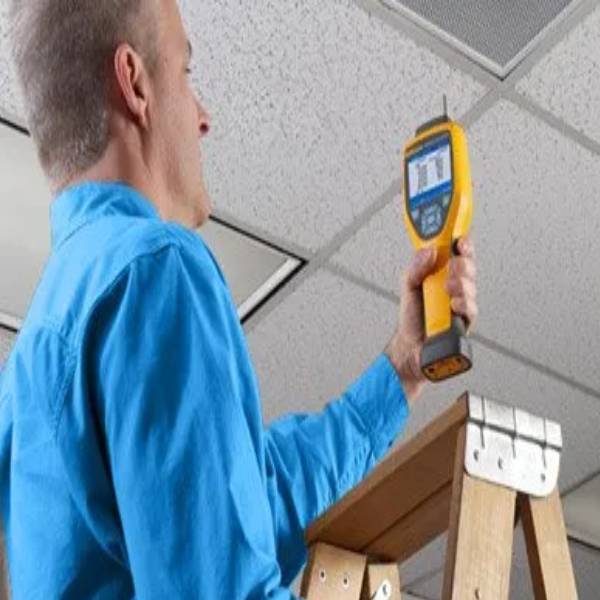What is indoor air quality testing?
Is the air quality within your home as it relates to your and your family’s health and comfort. Indoor pollution sources that release gases or particles into the air are the primary cause of IAQ problems in homes. Inadequate ventilation can increase indoor pollutant levels by not bringing in enough outdoor air to dilute emissions from indoor sources, and by not carrying indoor air pollutants out of the home. High temperature and humidity levels can also increase concentrations of some pollutants. Primary factors that affect IAQ are carbon monoxide, carbon dioxide, volatile organic compounds, particulates, temperature, and humidity.

- Molds are living things that produce spores. Molds produce spores that float in the air, land on damp surfaces, and grow. Inhaling or touching molds can cause hay fever-type symptoms such as sneezing, runny nose, red eyes, and skin rashes. Molds can also trigger asthma attacks. Indoor humidity can increase the likelihood of mold. Indoor humidity should be kept between 30 and 50 percent.
- Carbon monoxide (CO) is a colorless, odorless gas that interferes with the delivery of oxygen through the body. CO causes headaches, dizziness, weakness, nausea, and even death. Potential sources are defective central heating furnaces, automobile exhaust, tobacco smoke, and space heaters using fossil fuels. The solution to CO contamination is source removal.
- Carbon dioxide (CO2) is exhaled by humans and pets as a natural part of the metabolic process. High levels of CO2 can cause drowsiness and headaches. ASHRAE recommends that indoor CO2 levels not exceed 700 ppm above outdoor ambient levels. The solution for high CO2 levels is ventilation.
- Volatile organic compounds (VOCs) are chemicals found in home furnishings, carpets, building materials, paints and lacquers, cleaning supplies, waxes, pesticides, moth repellents, air fresheners, and dry-cleaned clothing. VOCs, evaporate into the air when these products are used or sometimes even when they are stored. Volatile organic compounds irritate the eyes, nose, and throat, and cause headaches, nausea, and damage to the liver, kidneys, and central nervous system. Some of them can cause cancer. Solutions for high VOC levels include ventilation and VOC destruction technologies.
- Particulates can induce eye, nose, and throat irritation; respiratory infections, bronchitis, and even lung cancer. Particulates include asthma triggers and mold.
- Asthma triggers include mold, dust mites, secondhand smoke, pet dander, as well as other pollutants in the air. Asthma triggers cause symptoms including coughing, chest tightness, wheezing, and breathing problems. Asthma attacks can be life-threatening. However, asthma can be controlled by reducing asthma triggers.
Particulate solutions include filtration, air cleaner systems, and de/humidification.
What Causes Indoor Air Pollution?
There are many factors that can cause indoor air pollution:
- The typical home generates approximately 40 pounds of dust a year per every 1500 square feet.
- There are over 4,000 compounds in tobacco smoke, many of which are strong irritants.
- Just one ounce of dust contains about 40,000 dust mites, which aggravate allergies.
- Carpets, furniture, bathrooms, damp basements, and other seemingly benign household items can contribute to indoor air pollution.
- Tobacco smoke and wood smoke are common causes of indoor air pollution.
- Flowers and trees are both pollen sources, but surprisingly trees affect allergy sufferers more. Trees like alder, pine, and birch do not rely on insects to distribute pollen. They rely on wind, and this means their pollen can regularly enter your home.
- Common activities such as cooking, cleaning, and remodeling cause the spread of indoor contaminants.
- Perfume, paint, air fresheners and hairspray cause indoor air pollution.
What is causing indoor air pollution in your home? Get an indoor air pollution test to find out. The results could be surprising. Significantly lowering indoor air pollution is normally not that difficult, but you have to know what you are dealing with.
Do I Need an IAQ Test?
Indoor air pollution and its health implications are a rapidly growing concern for families in today’s society. You want your family to be safe from the air pollution problems found in the outside environment, yet you may be unaware that indoor air pollution can have a major effect on your family’s health, comfort, and safety as well.
The EPA has identified indoor air pollution as one of the top five urgent environmental risks to public health. Indoor air pollution contributes to lung disease, including respiratory tract infections, asthma, and lung cancer, and can greatly exacerbate allergy symptoms. If you or a family member suffer from allergies or asthma, or if you have infants or elderly persons living at home, indoor air pollution and its health implications are of even greater concern to you.
Even healthy adults can experience adverse symptoms with as little as a single exposure to indoor air pollution. Some common symptoms are headaches, nausea, sore or scratchy throat, nasal irritation, dry, red, or watering eyes, coughing, and fatigue.
Common indoor air pollutants
Get Now
Air Advice Sample Report
Why Hire
1st Rate Inspection?
We are a premier home inspection company serving Houston for 12 years with the highest quality, We guarantee thorough, confidential, and unbiased 4.9-star rating home inspections. Our professionalism, integrity, and personal attention are what sets us apart. You can call 1st Rate Inspections with your inspection needs and expect to receive the best custom-tailored home inspection specific to your property. Along with high standard inspections, we employ state-of-the-art technology to assist our home inspectors. In addition, our professional home inspectors give you instant feedback on the outcome of each inspection and allow you to view each documentation through a detailed report after your property has been inspected.
Contact Us



